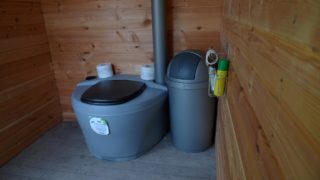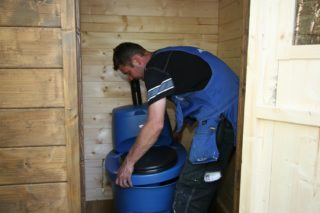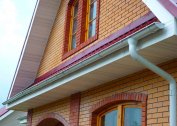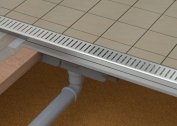One of the most important buildings in any residential or partially residential area is the toilet. The best choice for a summer residence is a toilet without a cesspool. This design has a number of important advantages compared to a traditional building (mobility, lightness and ease of construction). Even a novice master can install such a closet, since complex installation and construction work is not required.
Types of toilets without cesspool
 A country toilet without a cesspool is an ergonomic option for areas where there is no equipped sewer system. The following varieties of such structures are distinguished.
A country toilet without a cesspool is an ergonomic option for areas where there is no equipped sewer system. The following varieties of such structures are distinguished.
The first type is peat or composting models. Near the toilet seat there is a special box in which peat is poured. This substance is a catalyst and a kind of “duster” for waste. After filling the peat tank, it needs to be removed, cleaned. Peat toilet can be made independently or purchased already completely ready. In finished devices, peat is poured into the container through a special hopper - a hole located under the lid.
The following are electrical models. The toilet has 2 independent containers: for feces and for liquids. Liquid waste evaporates, discharges into the sewer or drainage system, solid waste is dried to a powder state using an installed compressor. For the smooth operation of the device requires constant electric current. Some models are equipped with a rechargeable battery.
The third type is chemical (liquid) toilets. The model consists of 2 vertically arranged containers:
- for water;
- for fecal matter.
This is a fairly simple design. To begin work, it is necessary to fill in water, add a special chemical or biological reagent for waste processing. The model has a different storage capacity (from 12 to 24 liters). There are also special valves to facilitate tank cleaning. An additional convenience is the equipping of toilets with comfortable seats.
Advantages and disadvantages of each type
 Peat construction has the following advantages - it is environmentally friendly and completely safe for the environment, the absence of chemical components. Waste is processed into compost, which can later be used as fertilizer. An advantage is the relatively long period between cleaning the toilet tank: for a family of 4 people, repeat the action no more than 1 time per month.
Peat construction has the following advantages - it is environmentally friendly and completely safe for the environment, the absence of chemical components. Waste is processed into compost, which can later be used as fertilizer. An advantage is the relatively long period between cleaning the toilet tank: for a family of 4 people, repeat the action no more than 1 time per month.
Among the shortcomings of the peat closet is regular peat filling and the arrangement of a ventilation system.
The next type is electric. Among the design advantages:
- maintaining operability at temperatures below 0;
- sparse cleaning of waste bins (no more than 3 times a year);
- no reagent purchase costs;
- Dried waste is very lightweight and easy to dispose of.
Among the drawbacks of the design are energy dependence and energy consumption, a higher cost, and a complicated construction device.
The strengths of chemical toilets are versatility and mobility of use, complete independence from communications, loyal pricing policy. Such closets are airtight and hygienic, do not emit stench. Weaknesses:
- the need to purchase reagents (materials to neutralize an unpleasant odor);
- increased frequency of tank cleaning;
- toxicity of recycled waste.
Selection of a place for installation
There are no strict rules and restrictions when choosing a place for such closets, since the waste will not be in direct contact with the environment. Any soil is suitable for the construction of this type of construction, long preparatory work is not required.But some nuances are still preserved.
- It is desirable to comply with SNiPa requirements - 8 m to the existing well and 12 m to residential buildings.
- A distance of at least 1 m from the boundaries of the site.
- Convenient access to the toilet (if the plans include cleaning the tanks with a wastewater machine).
The recommendations presented are only wishes for execution. Many models of dry closets can be placed directly in the house or in a car trailer.
Erection and installation
 The easiest option is to purchase a ready-made house or booth. But if you have free time, you can assemble the structure yourself. Necessary materials:
The easiest option is to purchase a ready-made house or booth. But if you have free time, you can assemble the structure yourself. Necessary materials:
- slate and roofing material;
- tiles or galvanized sheets;
- wood (boards, timber);
- plywood or lining;
- door block;
- auxiliary materials (nails, screws, dowels, clamps).
The following are the basic steps with a step-by-step description of the instructions. The first stage is the construction of the foundation. This stable foundation is necessary for a longer service life and for increased structural reliability. There are 2 options for performing an action.
- Tape. Dig a trench around the perimeter, cover the bottom with a pillow of sand (thickness - 10-20 cm). Next, make the formwork, reinforce it with metal bars, fix it with steel wire and pour it with concrete.
- Columnar. It is acceptable to use wooden, concrete or metal poles (at the choice of the owner). Such supports will prevent the displacement of angular supports.
The next stage is the construction of the frame. You will need a wooden beam with a section of 100x100 mm.
- Antiseptic treatment.
- Making a wooden frame.
- Installation and fastening on the foundation with dowels.
Next, vertical racks with finished beams for the roof are mounted on the finished base. The roof is covered with slate. A layer of roofing material is placed in front of it for better protection. Tightly laid boards are also used for the floor. For external wall cladding, siding or corrugated board is used, for the inner - lining.
The roof is recommended to be made at an angle so that rain does not accumulate on it. Therefore, the front struts should be 15-20 cm higher than the rear.
The final important step is the installation of the ventilation system. For this purpose, a plastic pipe or a corrugated pipe of small diameter is suitable. The lower end is attached 5-7 cm from the floor, the upper - 20 cm above the roof. The pipe is mounted to the rear wall of the toilet using clamps. A deflector is put on the top of the pipe - an aerodynamic device for better air draft.
So, a toilet without a cesspool is an excellent choice for summer cottages. Such designs are mobile and easy to operate, their installation does not require complex installation. Closets are divided into types: peat, electric, liquid. Each view has its pros and cons. Before choosing a design, careful familiarization with all the nuances is recommended.


